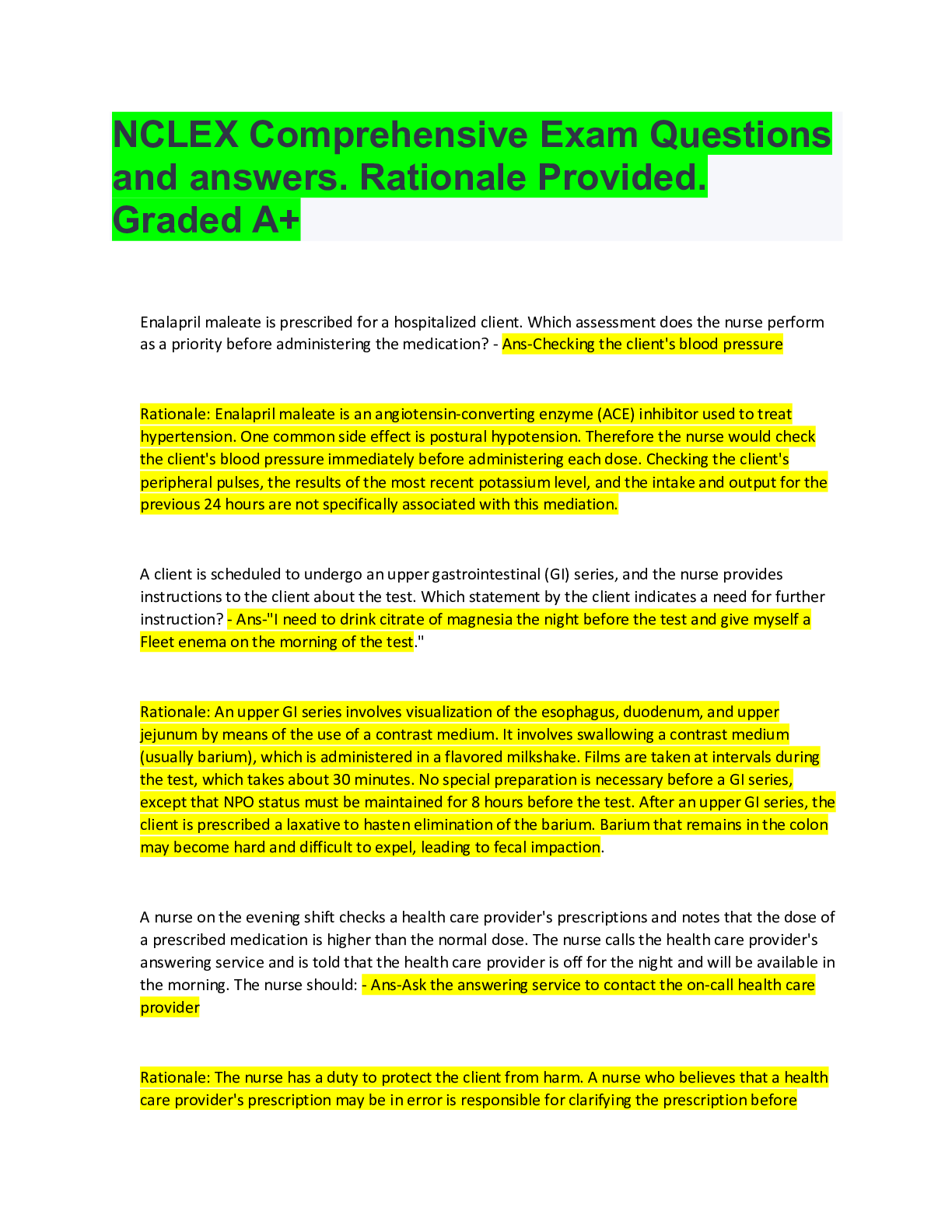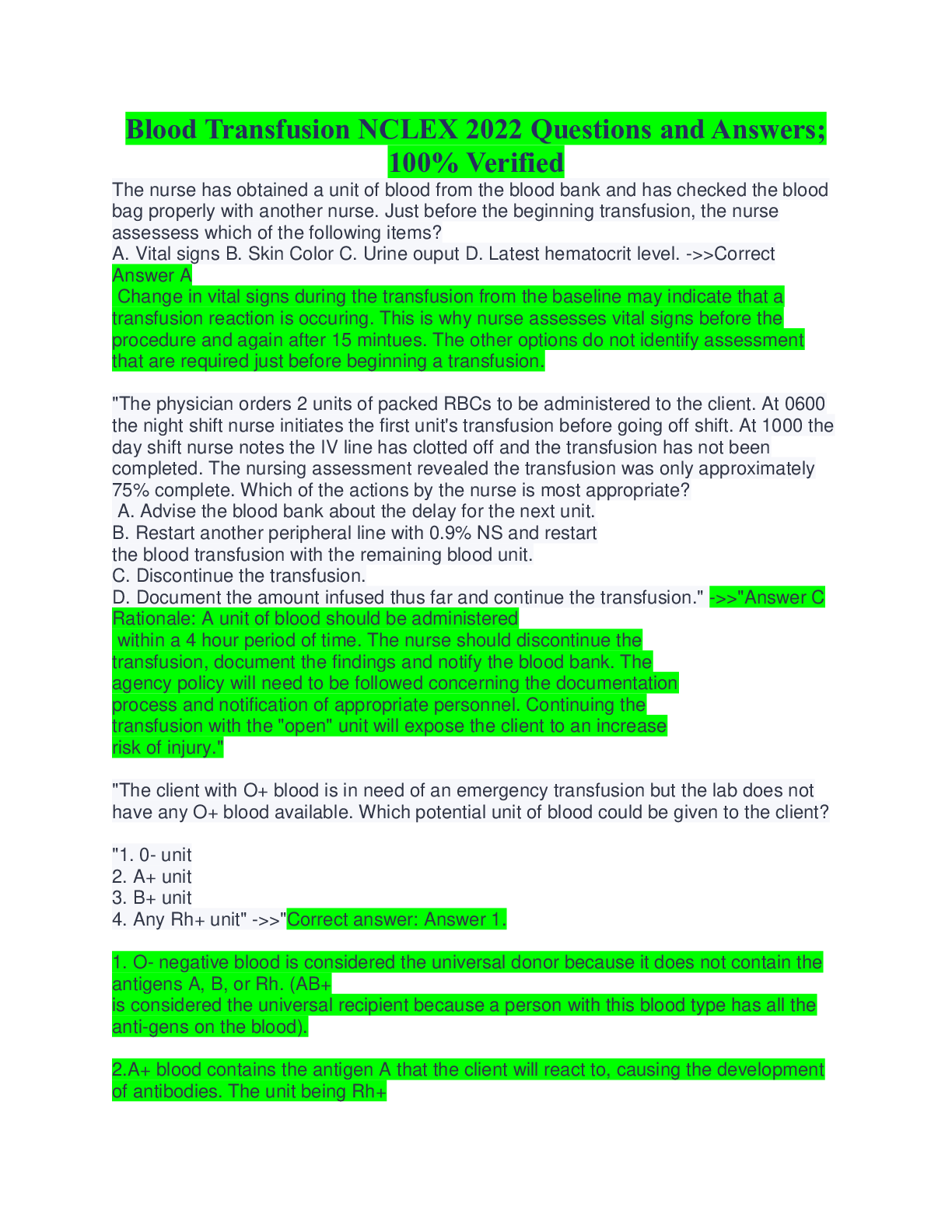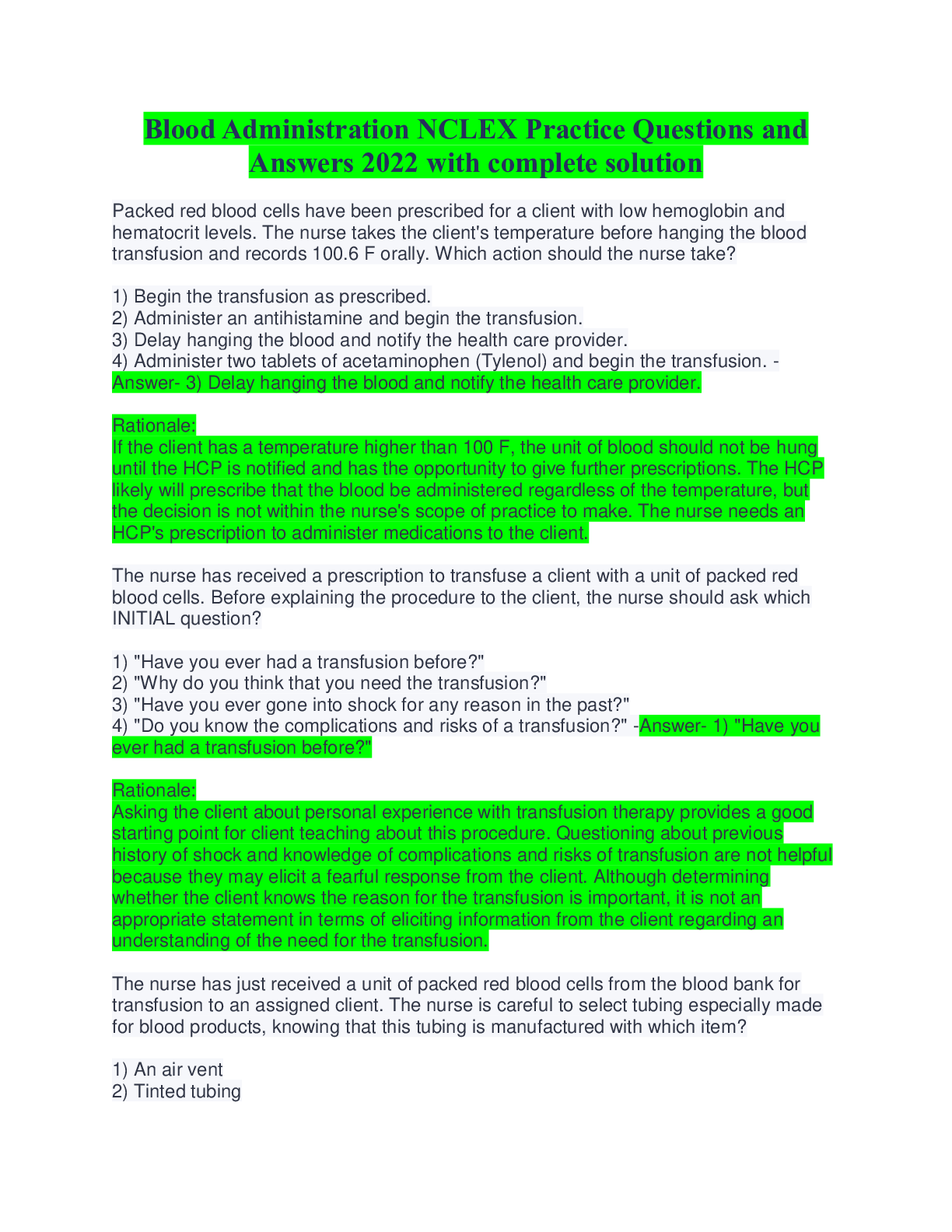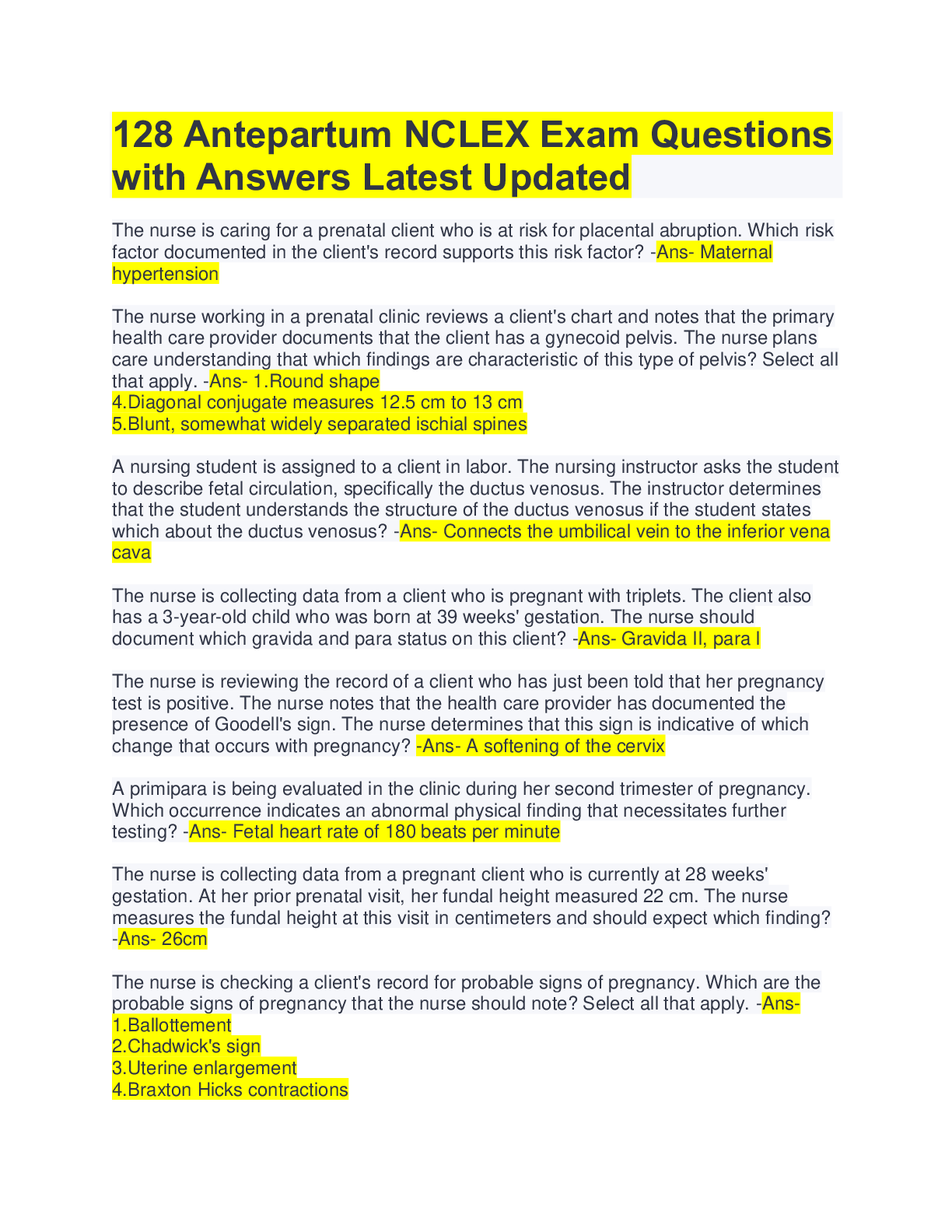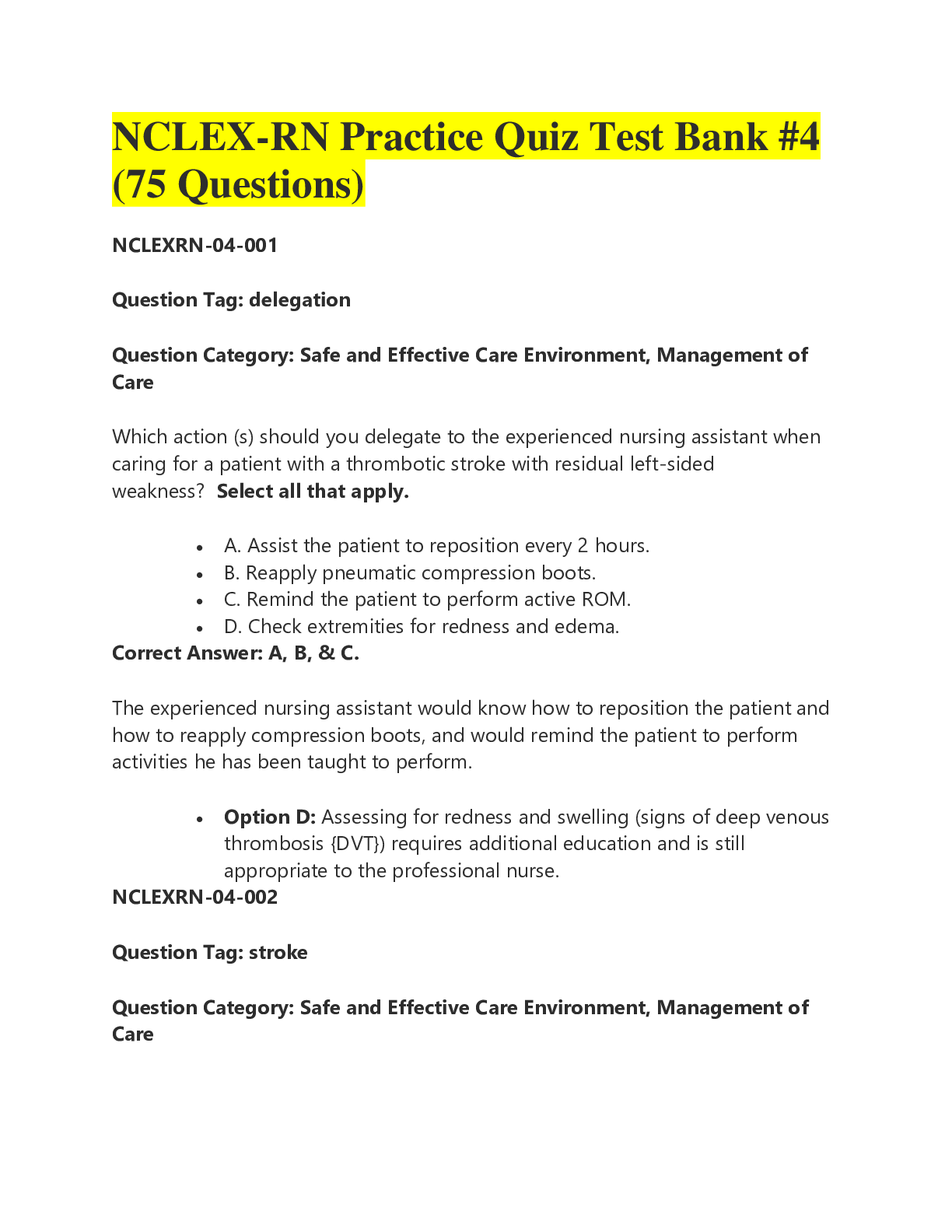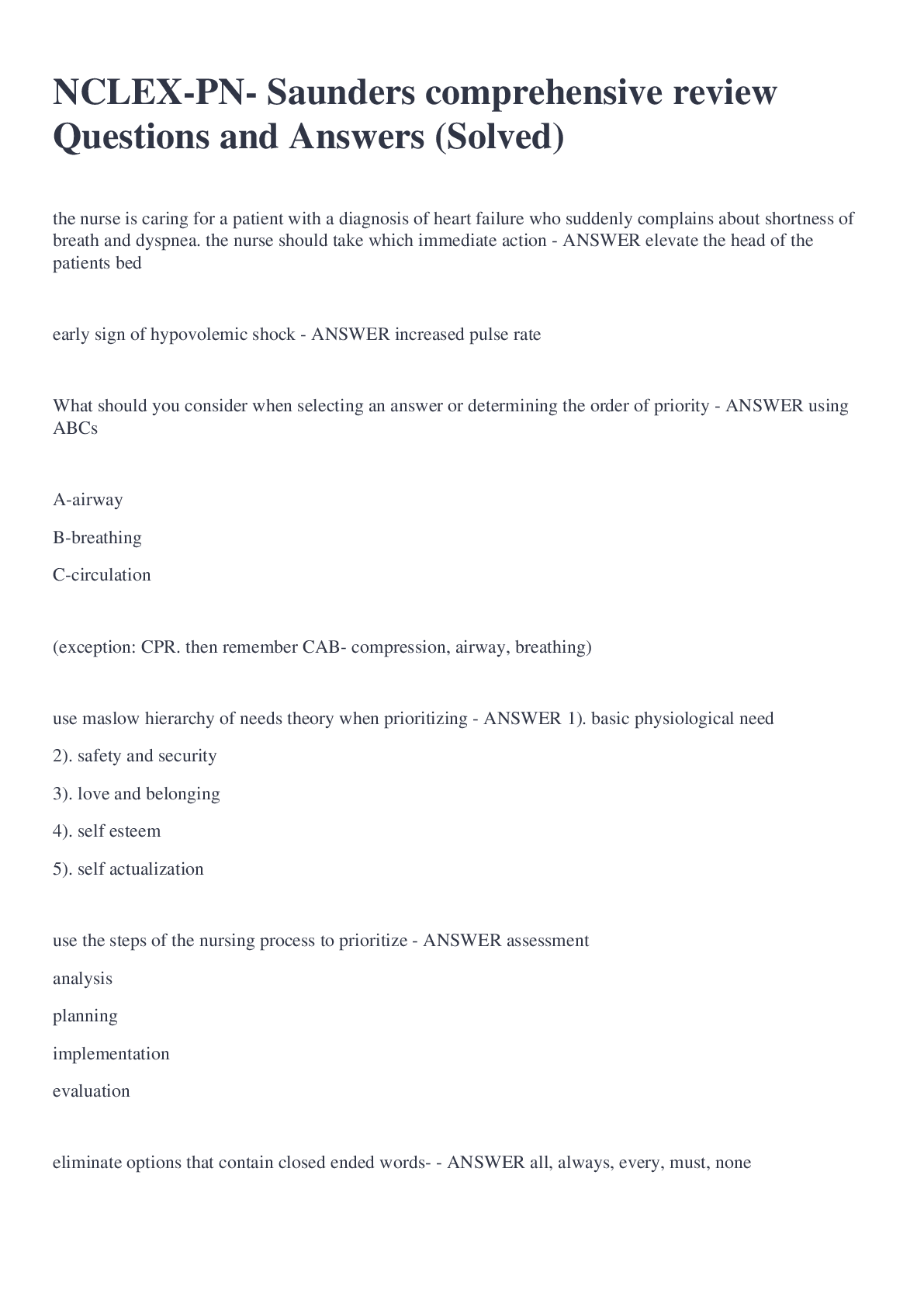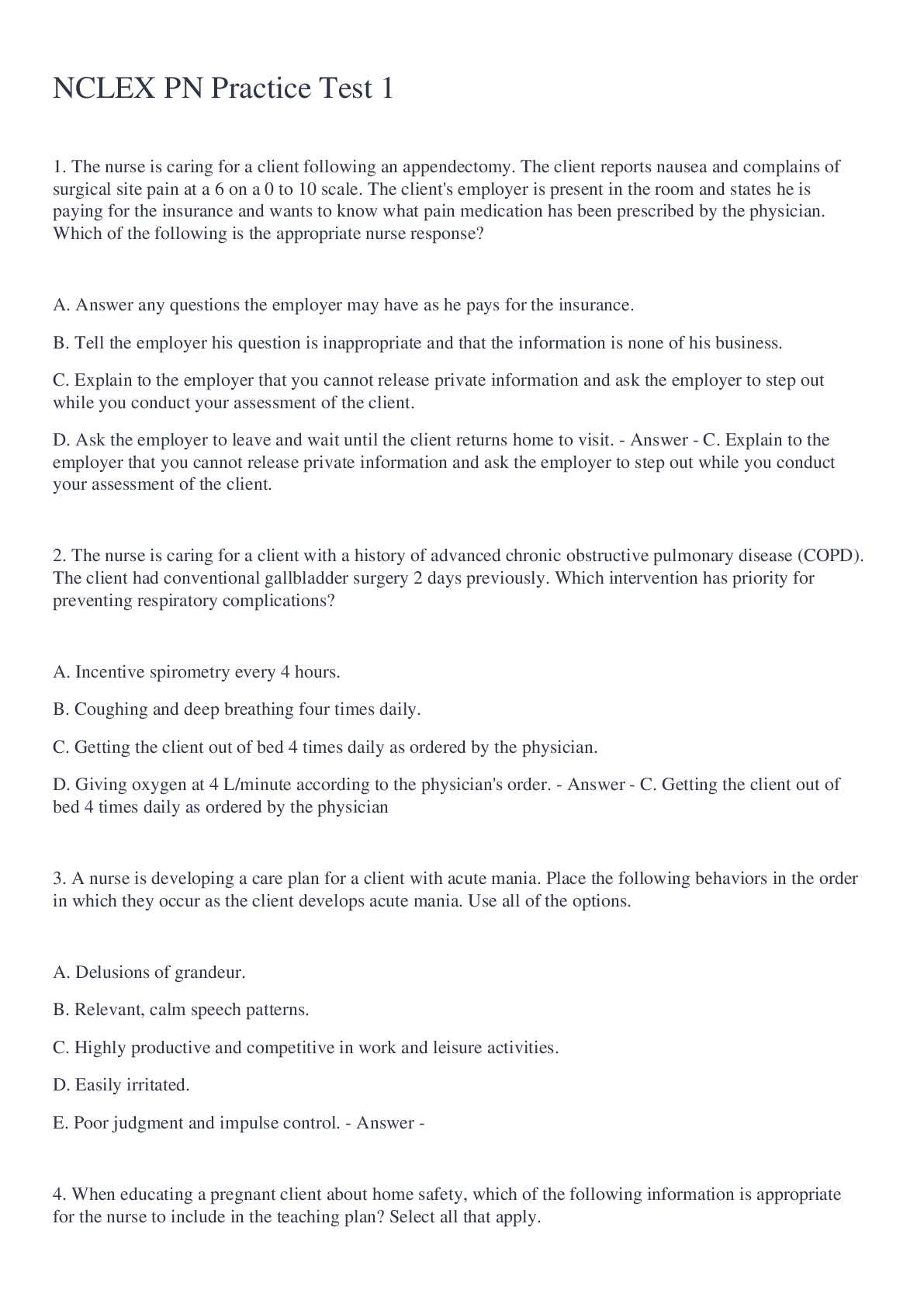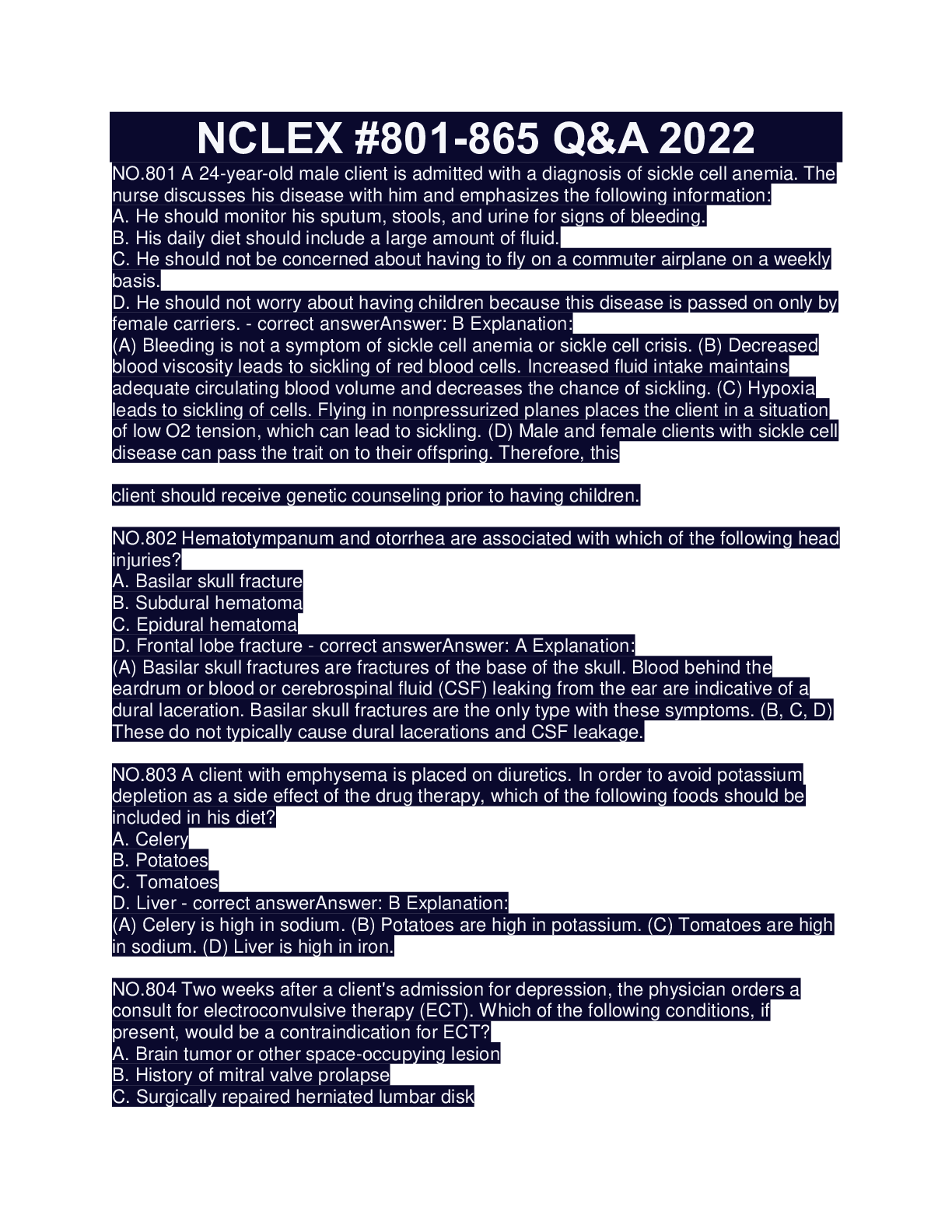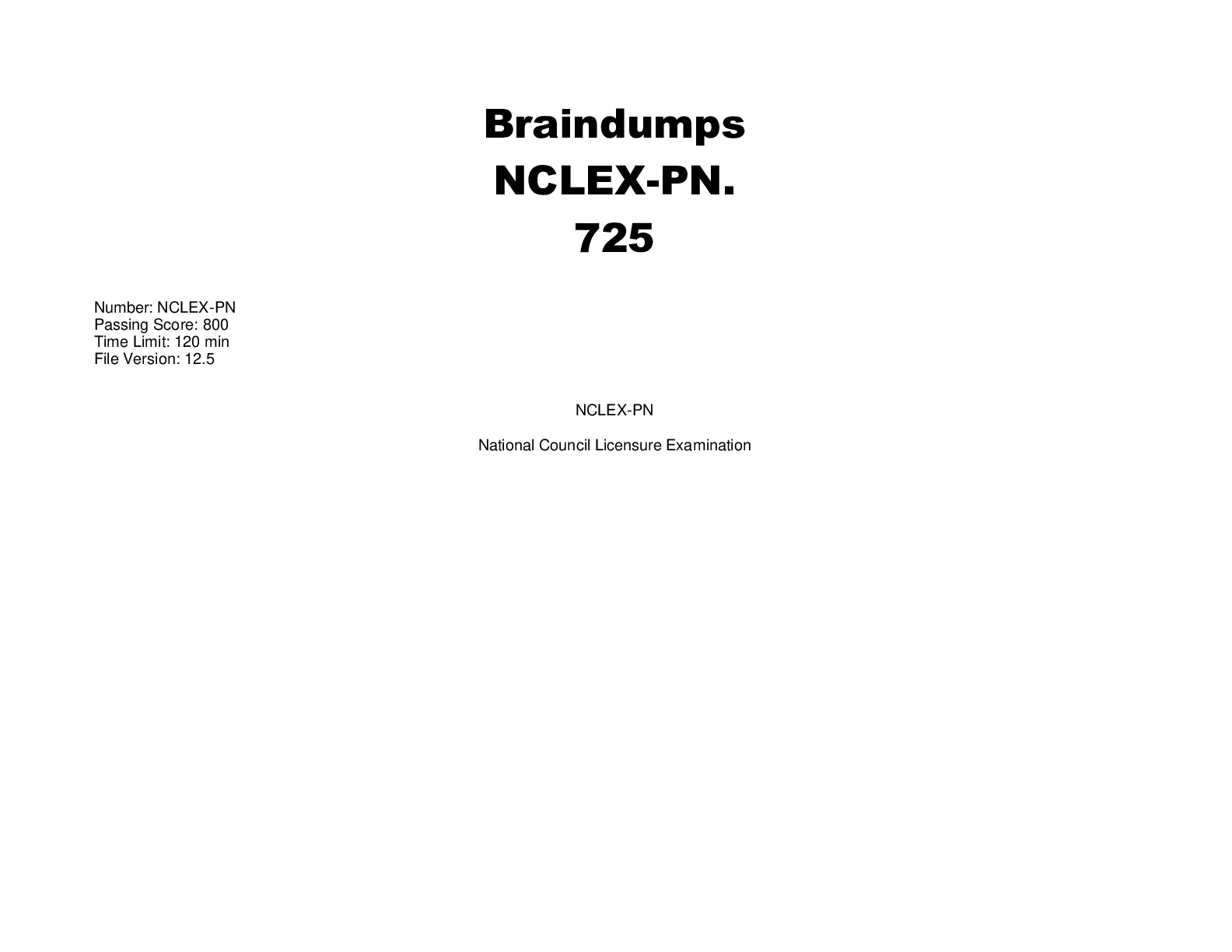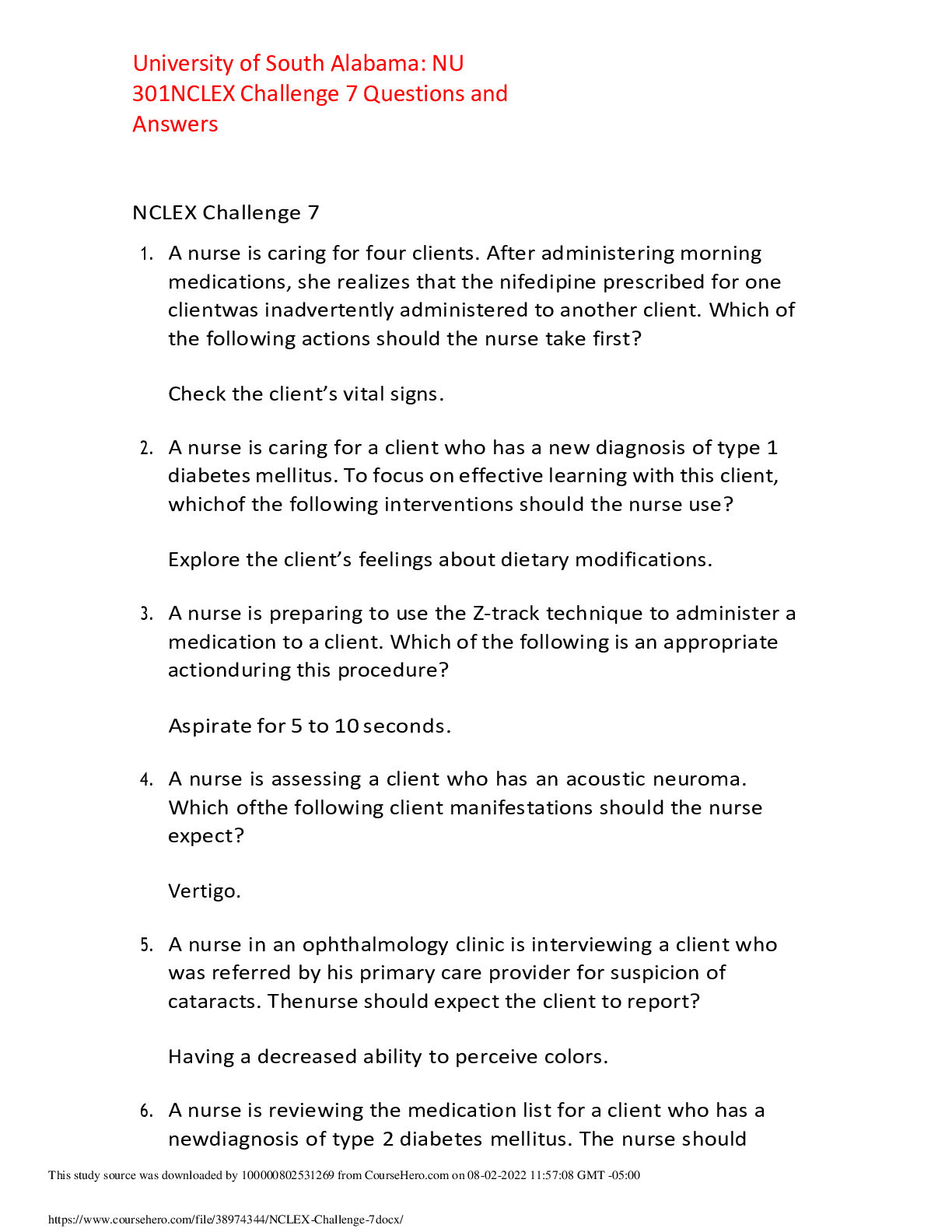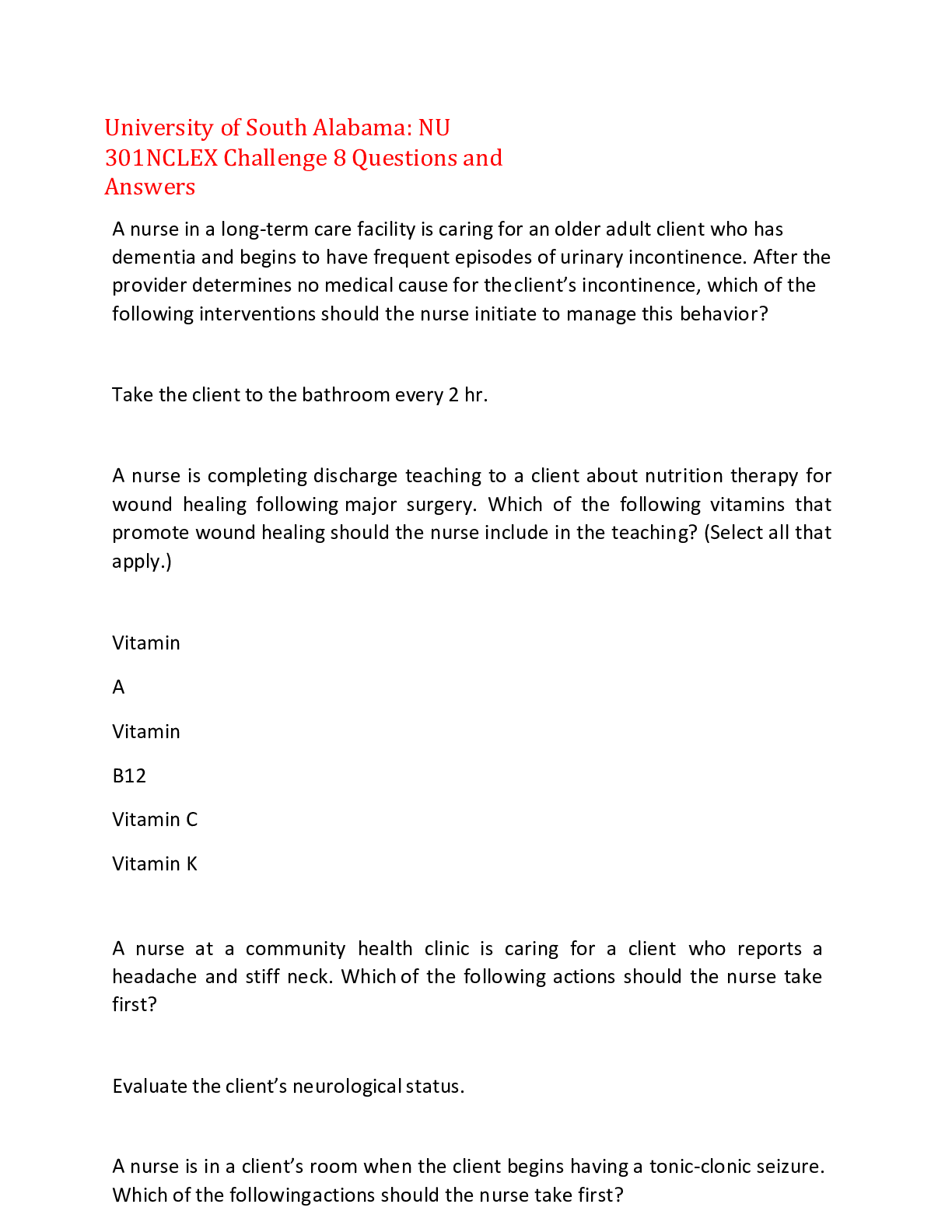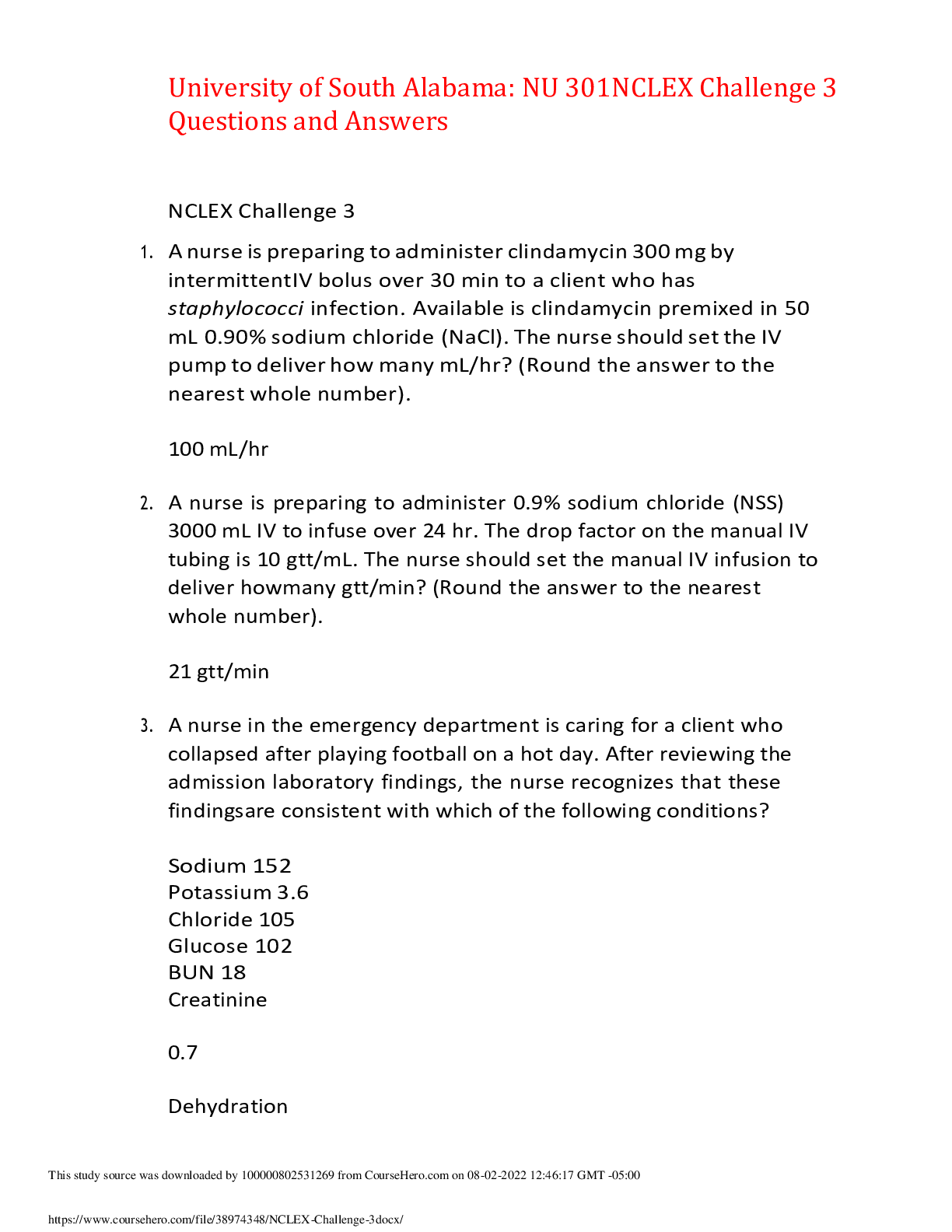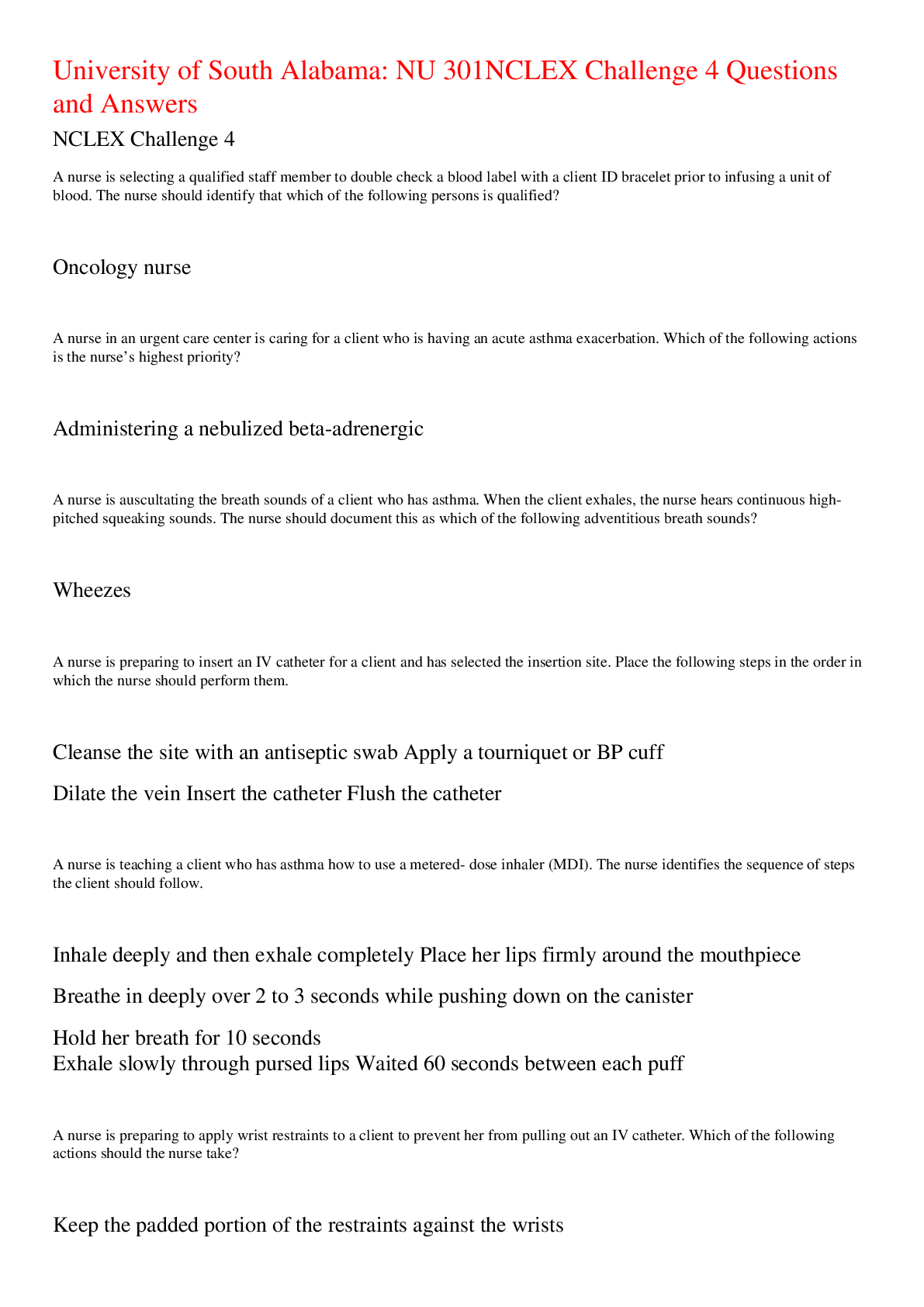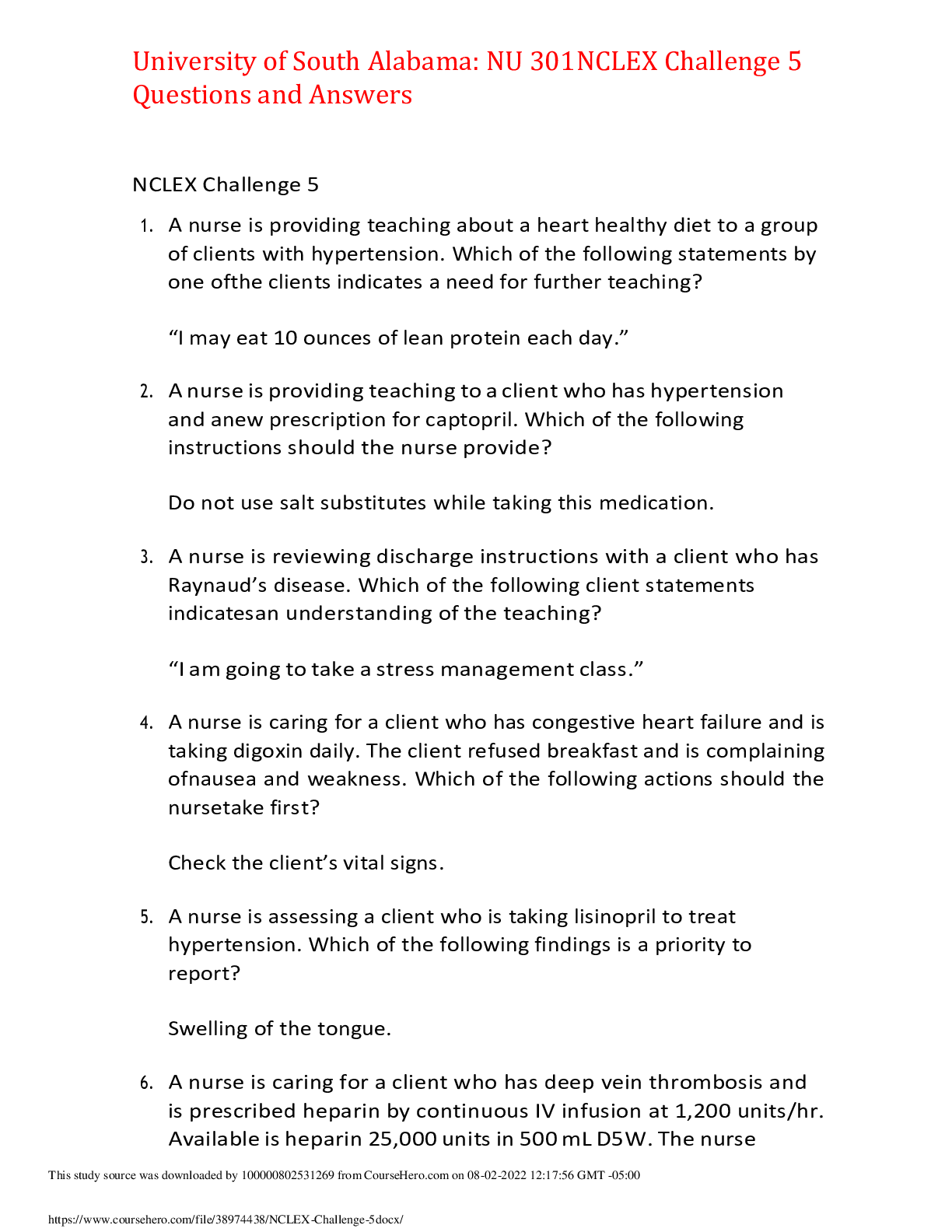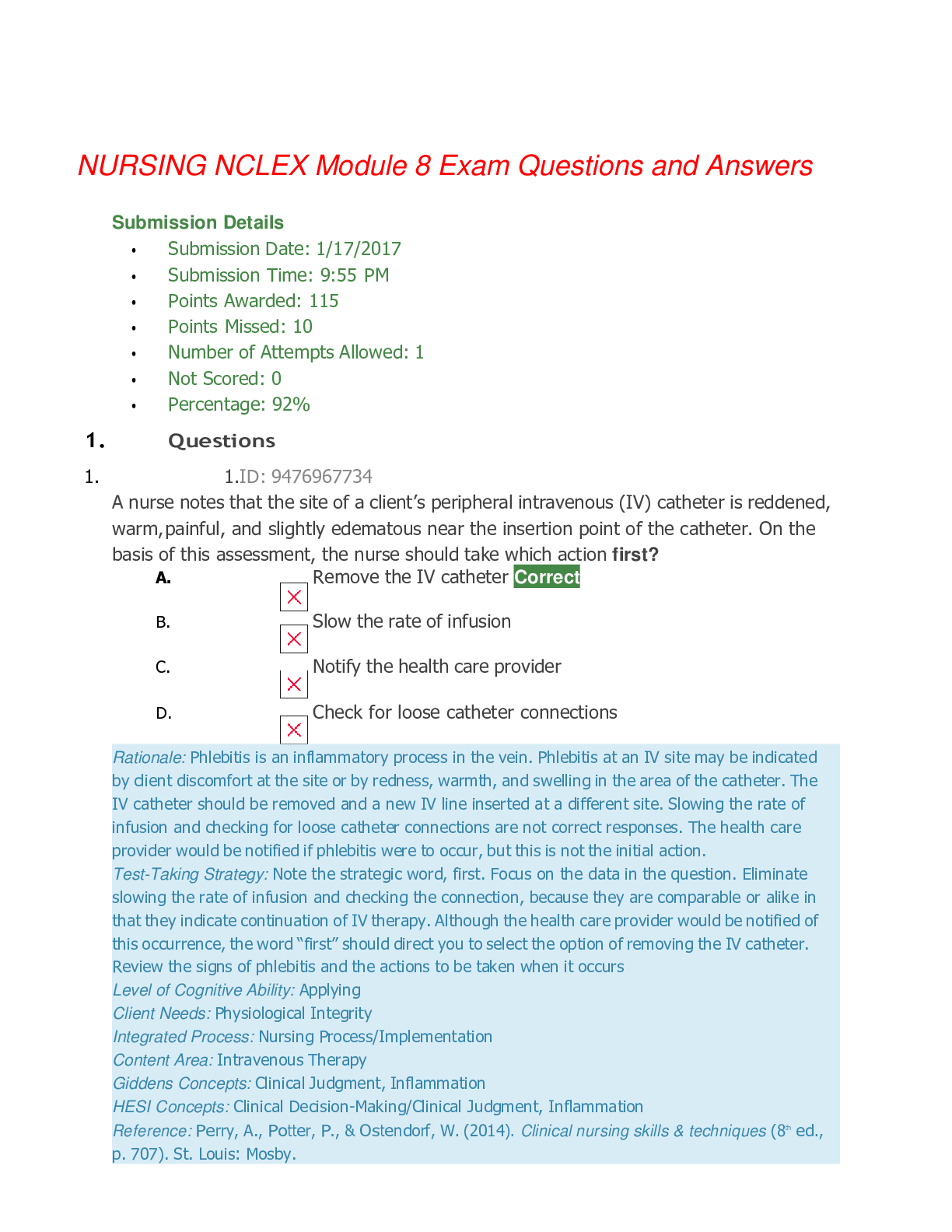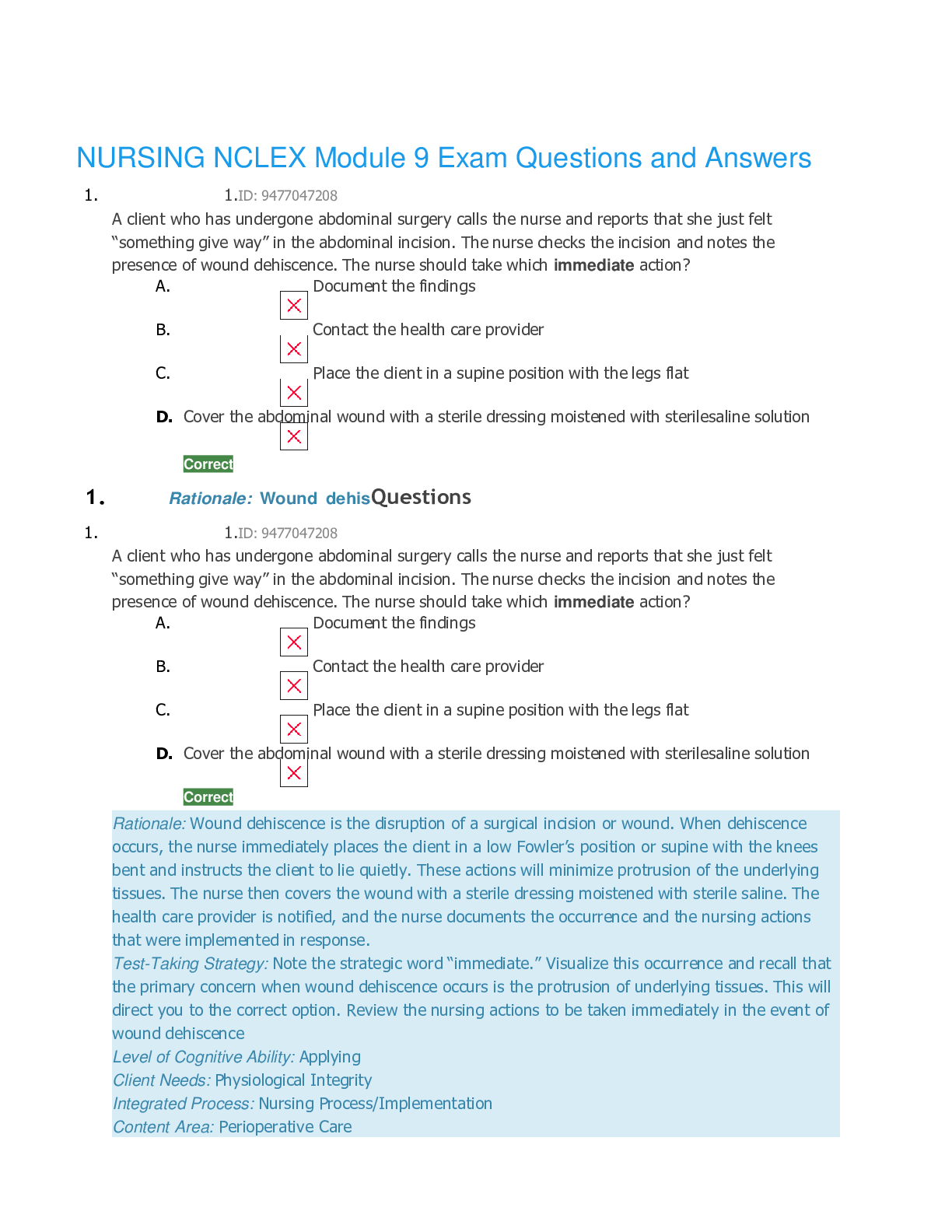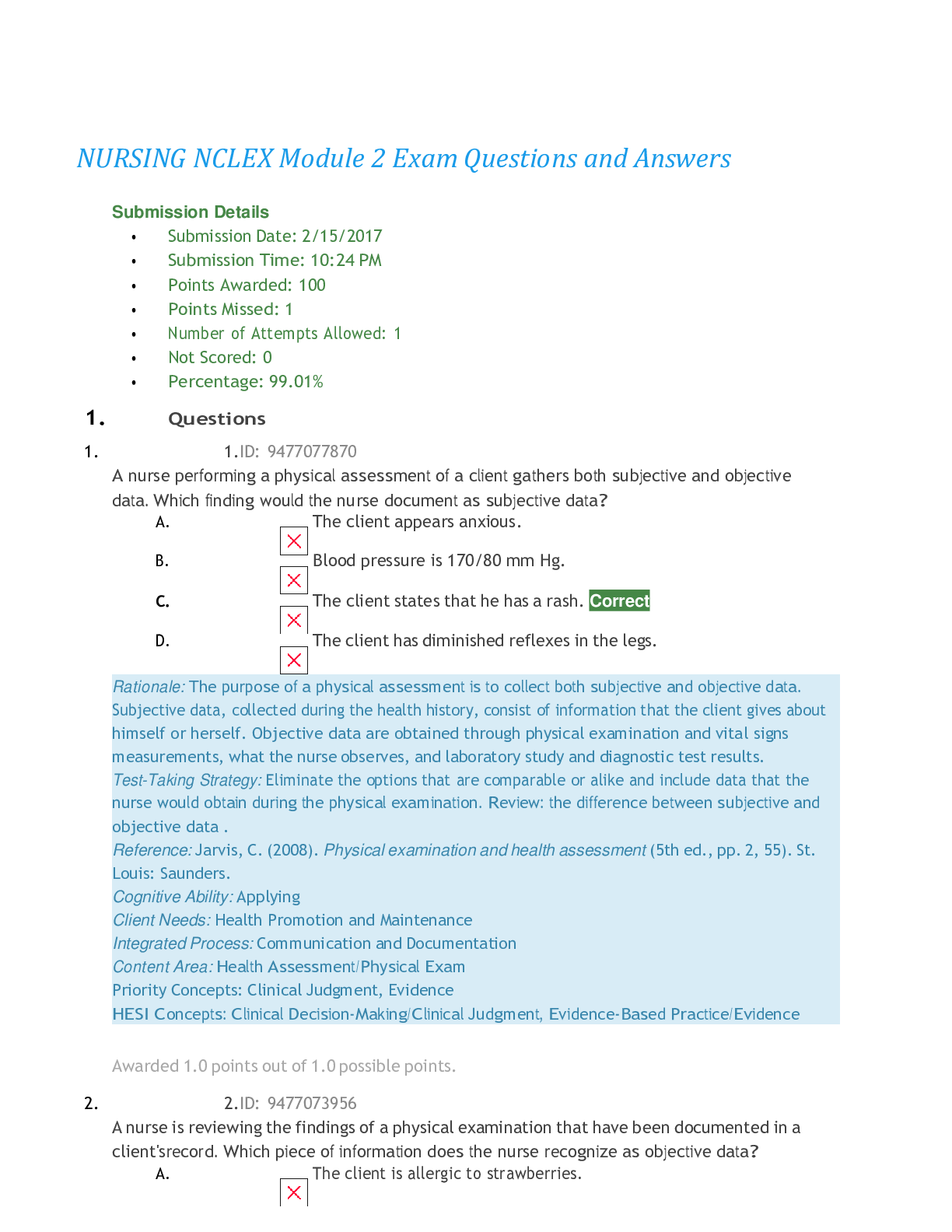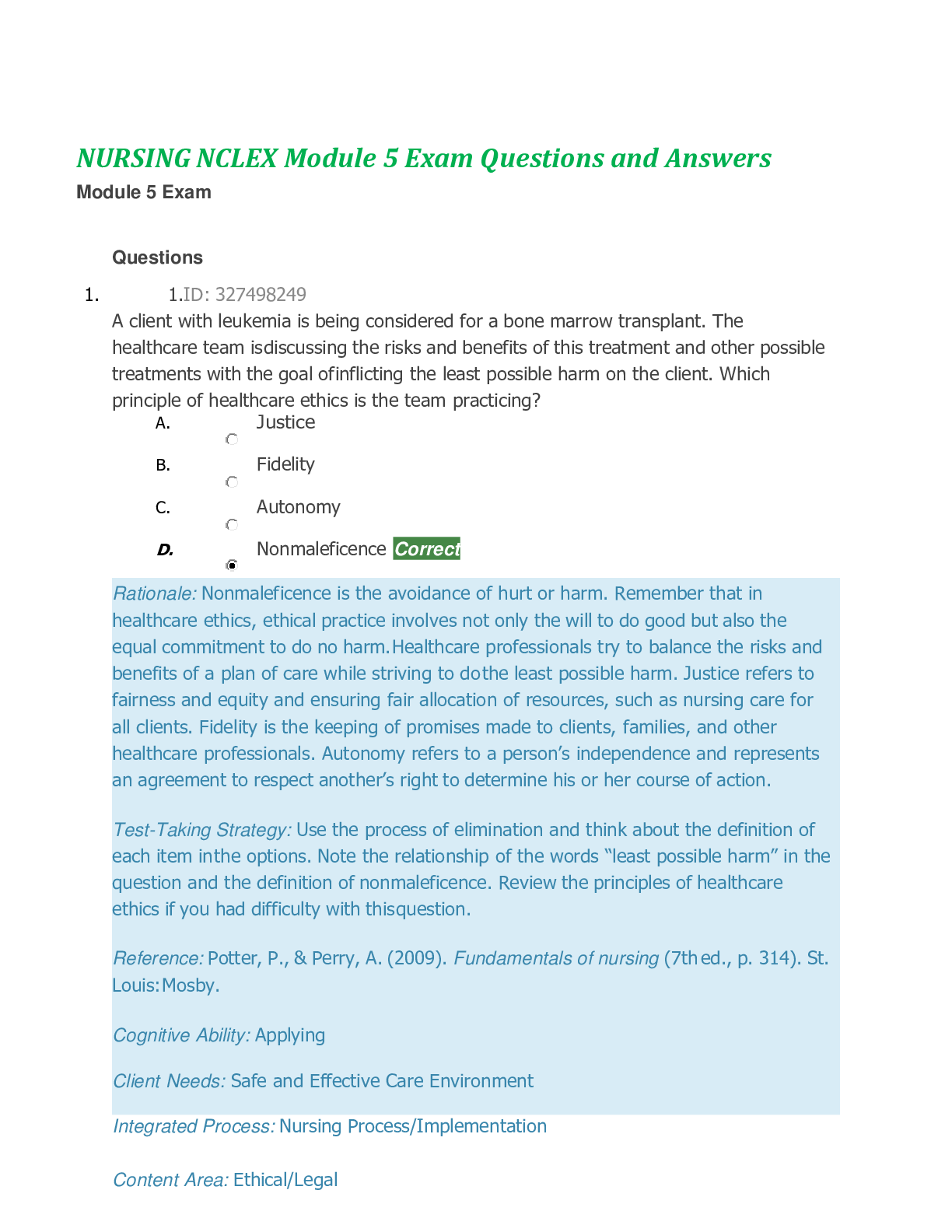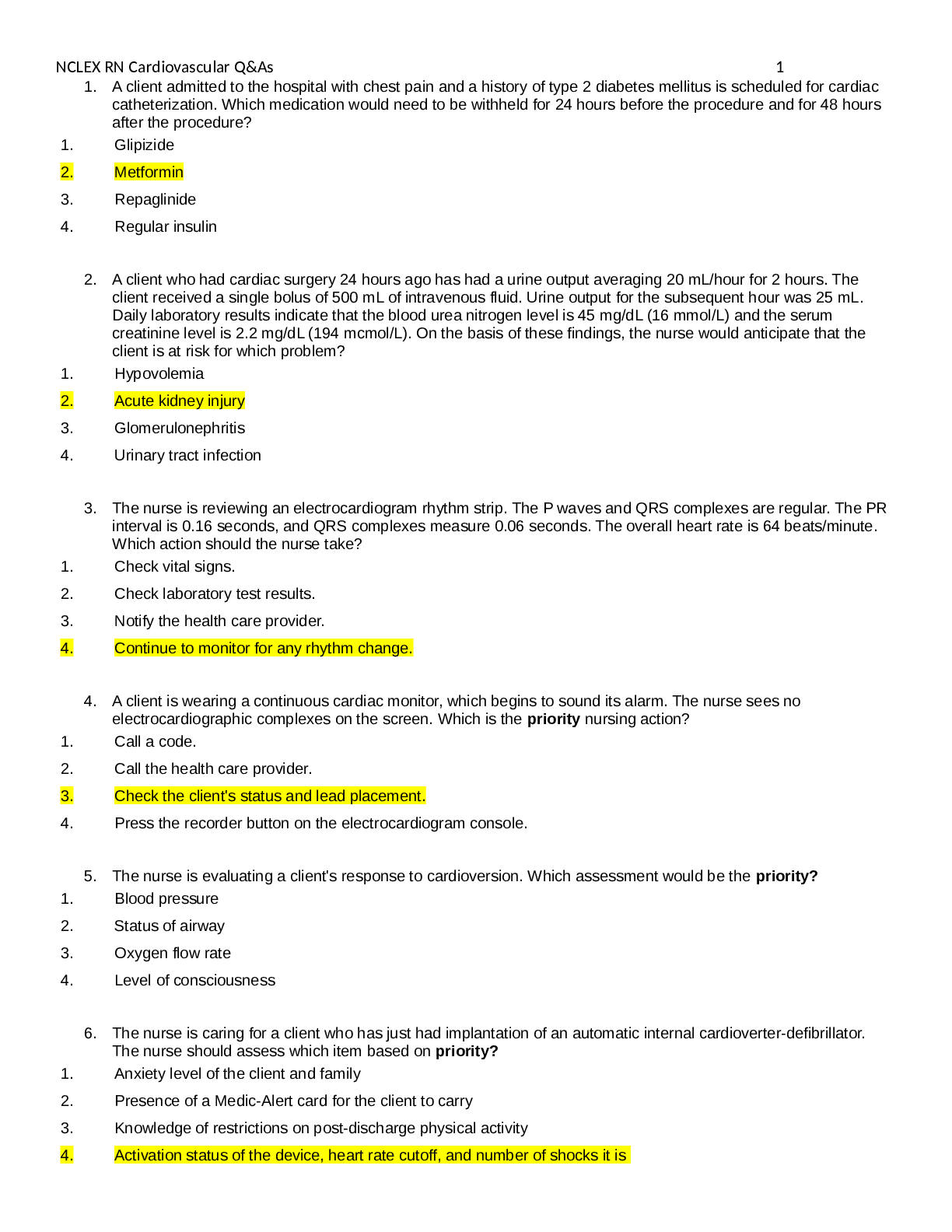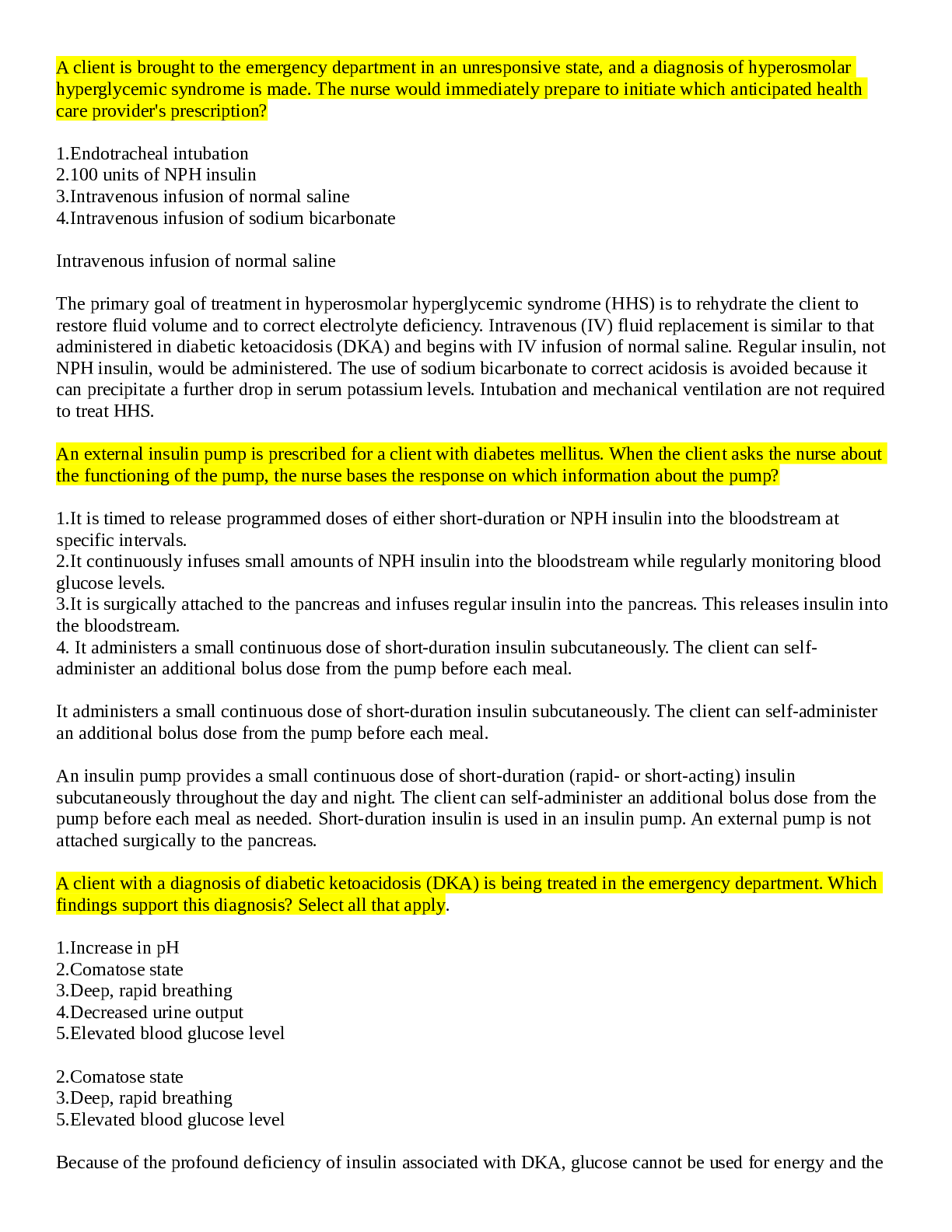*NURSING > NCLEX > N211 Exam 1 The Safe & Effective Care Environment: Safety & Infection Control Practice Questions and (All)
N211 Exam 1 The Safe & Effective Care Environment: Safety & Infection Control Practice Questions and answers, Graded A+
Document Content and Description Below
N211 Exam 1 The Safe & Effective Care Environment: Safety & Infection Control Practice Questions 1. Your client has an allergy to both penicillin and latex. Which of these pathophysiological fact... s should you apply when you are providing to this client? A. The sensitizing dose of penicillin can lead to anaphylaxis B. The second dose of penicillin can lead to distributive shock C. You should be aware of the fact that about 10% of the population has an allergy to both penicillin and latex D. You should be aware of the fact that about 20% of the population has an allergy to both penicillin and latex 2. Which of these client is at greatest risk for falls? A. A 77-year-old female client in a client room that has low glare floors B. An 87-year-old female client in a client room that has low glare floors C. A 27-year-old sedated male client D. A 37-year-old male client with impaired renal perfusion 3. Which statement about environmental safety is accurate? A. The nurse should advise clients in a smoke filled room to open the windows B. The first thing that the nurse should do when using a fire extinguisher to put out a small fire is to aim the fire extinguisher at the base of the fire C. Rapidly life and move a client away from the source of the fire when their slippers are on fire D. The home health care nurse should advise the client that the best fire extinguisher to have in the home is an ABC fire extinguisher 4. Which of the following is considered an internal disaster? A. A tornado that has touched down on the healthy care facility B. A severe cyclone that has destroyed nearby homes C. A massive train accident that brings victims to your facility D. An act of bioterrorism in a nearby factory 5. After your assessment of your client and the need to transfer your client form the bed to the chair, what is the best and safest way to transfer this paralyzed client when you suspect that you will need the help of another for the client’s first transfer out of bed? A. Use a slide board B. Use a mechanical lift C. Use a gait belt D. Notify the client's doctor that the client cannot be safely transferred by you 6. You are serving as the preceptor for a newly graduated nurse. As you observe the new nurse for their application of body mechanics principles into client care, you observe that the nurse spreads her legs apart during a transfer with a client. What should you do? A. Advise the nurse that the legs must be close together for stability during lifting and transfers B. Advise the nurse that the legs should be one in front of the other and not spread apart during a transfer C. Validate the nurse’s competency in term of the application of body mechanics principles during a 1transfer D. Validate the nurse’s competency in terms of the application of ergonomics principles during a transfer 7. You are serving as the supervisory nurse for a home healthcare agency in the community. You are doing an admission assessment for a 76- year-old male client who resides with his elderly wife. Which of the following assessments would indicate that the couple needs some education relating to home safety? A. The client has refrigerated foods labelled with an expiration date B. You assess that the home is free of scatter rugs that many use to protect the feet against hard floors C. The client uses the FIFO method for ensuring food safety D. The client assures you that the smoke alarm batteries are replaced annually to insure that they work 8. Which characteristic of carbon monoxide makes it a particularly dangerous gas? A. It is clear B. It is damaging to the lungs C. It is damaging to the spleen and the liver D. It leads to the overproduction of hemoglobin 9. The lack of necessary supplies and equipment to adequately and safely care for patients is an example of a(n): A. Sentinel event B. System variance C. Adverse effect D. Provider variance 10. The first thing that you should do immediately after a client accident is to: A. Notify the doctor B. Render care C. Assess the client D. Notify the nurse manager 11. You have collected, aggregated and analyzed data which reflects the frequency of your staff returning medical equipment to the appropriate department because the staff members that it was too unsafe to use. After the experts in the medical equipment inspect and test the equipment they report back to you, as the nurse manager, whether or not the equipment was indeed unsafe. This data indicates that 83% of the returns that were made by your staff were deemed safe and operably. What should you do? A. Counsel the staff about their need to stop wasting the resources of this department B. Check the equipment yourself to determine the accuracy of this equipment department C. Ignore it because everyone can make an innocent mistake D. Plan an educational activity about determining what equipment to send for repairs 12. Which of the following is an essential component for insuring that medical equipment is being used safely and properly by those who are supervise? A. Education and training on all pieces of equipment B. Pilot testing new equipment C. Reading all the manufacturer's instructions D. Researching the equipment before recommending its purchase 213. Which of the following security concerns is also a sentinel event that must be reported? A. A possible vulnerability of the facility’s information technology of hacking B. The assisted suicide of a client in your facility by the spouse of the client C. Vulnerability to computer hacking D. Potential information theft 14. Which of the following is an effective security plan that you may most likely want to consider for implementation within your facility? A. Training all nurses to serve as a part of a security response team B. Training all clerical staff to be a part of a security response team C. The restriction of visitors in a special care area D. Bar coded client identification bands to insure proper identification 15. Select the basic sterile asepsis procedures that are accurate. (SELECT ALL THAT APPLY): A. Sterile items ONLY are placed on the sterile field B. The nurse must keep the sterile field below waist level C. Coughing or sneezing over the sterile field contaminates the sterile field D. The nurse must maintain a ½ inch border around the sterile field that is not sterile E. Moisture and wetness contaminate the sterile field F. Sterile masks are used by staff and the client when a sterile field is being set up and/or maintained 16. Select the term which is most completely and accurately paired with its definition. A. A physical restraint: a physical restraint is a manufactured device that is used, when necessary, to prevent falls B. A physical restraint: a physical restraint is any mechanical device, material, or equipment attached to or adjacent to the resident’s body that the individual cannot remove easily which restricts freedom of movement or normal access to one’s body C. A chemical restraint: a chemical restraint is a drug used for sedation to prevent falls D. A chemical restraint: a chemical restraint is a drug used for discipline or convenience and not required to treat medical symptoms 17. Which of the following is NOT an essential component of a restraint order? A. Informed consent for the restraint B. The reason for the trestraint C. The type of restraint to bed used D. Client behaviors that necessitated the restraints 18. Place the phases or stages of the inflammatory response in the correct sequential order, do NOT include any phases that is NOT part of the inflammatory process: a. The vascular phase b. The prodromal phase c. The incubation phase d. The initial injury e. The exudative phase f. The convalescence phase A. 4, 2, 1 B. 4, 1, 5 C. 4, 5, 1 D. 4, 2, 5 3Answers 1. B → The second dose of penicillin can lead to anaphylactic shock which is a form of distributive shock. The first exposure to penicillin, referred to as the “sensitizing dose,” sensitizes and prepares the body to respond to a second exposure or dose. It is then the second exposure or dose that leads to anaphylaxis, or anaphylactic shock. It is estimated that approximately 10% of people have had a reaction to penicillin. Some of these reactions are an allergic response and others are simply a troublesome side effect. There is no scientific data that indicates that 10% or 20% of the population has an allergy to both penicillin and latex. 2. C → The 27-year-old sedated male client is at greatest risk for falls. Some of the risk factors associated with falls are sedating medications, high flare, not low glare, floors and other environmental factors such as clutter and scatter rugs, not low glare floors, a history of prior falls, a fear of falling, incontinence, confusion, sensory deficits, a decreased level of consciousness, impaired reaction time, advancing age, poor muscular strength, balance, coordination, gait and range of motion and some physical disorders, particularly those that affect the musculoskeletal or neurological systems; falls are not associated with poor and impair. 3. D → The home healthcare nurse should advise the client that the best fire extinguisher to have in in the home is an ABC fire extinguisher because this one fire extinguisher is a combination of a type A fire extinguisher, a type B and a type C, which put out all types of fires including common household solids like wood, household oils like kitchen grease and electrical fires. The nurse should advise the client GET LOW AND GO if a room fills with smoke. They should not take any time to open window. The first thing to do when using a fire extinguisher is to pull the pin and then aim it at the base of the fire. Later, you would squeeze the trigger and sweep the spray over and over again over the base of the fire. The acronym PASS is used to remember these sequential steps. When a person has clothing that has caught on fire, the person should STOP, DROP AND ROLL. Tell the person, to STOP, DROP, and to not run, and as you also cover the person with a blanket to smother the fire. 4. A → A tornado that has touched down on the healthcare facility is an example of an internal disaster because this tornado has directly affected the healthcare facility. Tornadoes, cyclones, hurricanes, and other severe weather emergencies can be both an internal disaster when they affect the healthcare facility and also an external disaster when they impact on the lives of those living in the community. Hurricane Katrina is a good example of a weather emergency that affected not only healthcare facilities but also members of the community. 5. B → The best and safest way to transfer this paralyzed client when you suspect that you will need the help of another for the client’s first transfer out of bed is to use a mechanical lift. It is not necessary or appropriate to notify the doctor. Mechanical lifts are used mostly for patients who are obese and cannot be safely moved or transferred by two people, and also for patients who are, for one reason or another, not able to provide any help or assistance with their lifts and transfers, such as a person who is paralyzed. A gait or transfer belt and slide boards are assistive devices that can be used to assist with transfers and lifting however, they are not appropriate for this client as based on your assessment. 6. C → You should validate the nurse’s competency in terms of the application of body mechanics principles during a transfer because the nurse had spread her legs apart during the transfer to provide a wide base of support, which is a basic principle of body mechanics and not ergonomics. Simply defined ergonomics addresses correct bodily alignment such as the lumbar curve accommodation in an ergonomically designed chair; and body mechanics is the safe use of the body using the correct posture, bodily alignment, balance and bodily movements to safely bend, carry, lift and move objects and people. 47. D → When the client assures the nurse that they replace their smoke alarm batteries annually to insure that they work, the assessing nurse should immediately know that the client is in need of education relating to the fact that smoke alarm batteries should be changed at least twice a year. The client has demonstrated that they are knowledgeable about food safety and environmental safety because they have expiration dates on refrigerated foods, they use the FIFO method for food safety and they do not use scatter rugs which can lead to falls. The FIFO rule is First In is First Out. In other words, the first foods in the pantry or refrigerator are the first foods that should be consumed or discarded. 8. A → Carbon monoxide is particularly dangerous because it is clear, invisible and odorless. Carbon monoxide poisoning can occur when a person is exposed to an excessive amount of this odorless and colorless gas; it severely impairs the body to absorb life sustaining oxygen which is the result of this deadly gas and not damage to the lungs. This oxygen absorption deficit can lead to serious tissue damage and death. For these reasons, home carbon monoxide alarms are recommended. These dangers are associated with deoxygenation and not splenic or hepatic damage or the over production of hemoglobin. 9. B → The lack of necessary supplies and equipment to adequately and safely care for patients is an example of a system variance. A variance is defined as a deviation that leads to a quality defect or problem. Variances can be classified as a practitioner variance, a system/institutional variance, a patient variance, a random variance and a specific variance. A sentinel event is defined as is an event or occurrence, incident or accident that has led to or may possibly lead to client harm. Adverse effects are serious and unanticipated responses to interventions and treatments, including things like medications. 10.C → The first thing you should do immediately after a client accident is assess the client and the second thing you should do is render care after this assessment and not before it. Lastly, notification to the doctor and the nurse manager are only done after the client is assessed and emergency care, if any, is rendered. 11.D → You should plan an educational activity about determining what equipment should and should not be sent for repairs. This data suggests that the staff members need education and training about the proper functioning of equipment used on the nursing care unit. Counseling the staff about their need to stop wasting the resources of this department is placing blame and this blame may prevent future valid returns of equipment. You should not check the equipment yourself to determine the accuracy of this equipment department because they are the experts, not you, with these matters. You should also not ignore it because everyone can make an innocent mistake. The issue has to be addressed and corrected. 12.A → Education and training on all pieces of equipment is an essential component for insuring that medical equipment is being used safely and properly by those who you supervise. Other essential components include validated and documented competency to use any and all pieces of equipment by a person qualified to do so, preventive maintenance and the prompt removal of all unsafe equipment from service. Pilot testing new equipment, researching the equipment before recommending its purchase, and reading the entire manufacturer’s instructions are things done prior to the purchase of the equipment and these things do not impact on the safety of the piece of medical equipment. 13.B → The assisted suicide of a client in your facility by the spouse of the client is a security concern that is also a sentinel event that must be reported. A possible 5vulnerability of the facility’s information technology to hacking, vulnerability to computer hacking and potential information theft is security concerns but they are not sentinel events that must be reported. 14.C → The restriction of visitors in a special care area is an effective security plan that you may want to consider for implementation within your facility. Some of the other security measures that you may want to consider include security alert systems to alert staff to a security breach such as security breach of the newborn nursery, the use of visitor identification badges or stickers that identify people who are authorized to be in a facility, closed circuit monitoring and alarm systems in high risk areas such as the emergency care area, automatically locking security doors, and electronic wristbands for the newborn and the mother to prevent infant abductions. Special assignments and training for a group of people so that this specially trained group can act when a security breach occurs is also a good idea but it is not necessary to train all nurses or clerical staff; it is sufficient to train a limited group of people, provided an ample number of these team members are assigned and available on all tours of duty around the clock, including on holidays. 15.A, C, E → Sterile items ONLY are placed on the sterile field; coughing or sneezing over the sterile field contaminates the sterile field; and all moisture and wetness contaminate the sterile field. Some of the other principles that are applied to setting up and maintaining a sterile field include keeping the sterile field above the waist level and preventing coughing or sneezing by professional staff and the client during the set up and during the maintenance of the sterile field. If there is a danger that anyone may cough or sneeze over the field, the professional staff and/or the client should don a mask to prevent contamination. Lastly, a one inch border, not a ½ border that is not sterile is maintained around the perimeter of the sterile field. 16.D → A chemical restraint: A chemical restraint is a drug used for discipline or convenience and not required to treat medical symptoms, according to the Centers for Medicare and Medicaid Services. The most complete and accurate definition of a physical restraint is any manual method or physical or mechanical device, material, or equipment attached to or adjacent to the resident’s body that the individual cannot remove easily which restricts freedom of movement or normal access to one’s body and is NOT a safety devices that is routinely used for certain procedures, according to the Centers for Medicare and Medicaid Services. 17.A → The minimal components of orders for restraint include the reason for and rationale for the use of the restraint, the type of restraint to be used, h [Show More]
Last updated: 1 year ago
Preview 1 out of 16 pages

Reviews( 0 )
Document information
Connected school, study & course
About the document
Uploaded On
Aug 30, 2022
Number of pages
16
Written in
Additional information
This document has been written for:
Uploaded
Aug 30, 2022
Downloads
0
Views
117

